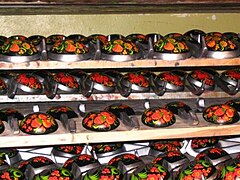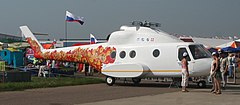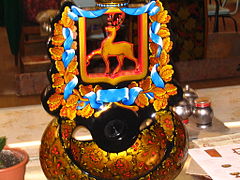Chochloma

Khochloma ( Russian Хохлома ) or Khochloma painting ( Russian Хохломская роспись ; transcribed: Khochlomskaja rospis) is an ancient Russian handicraft. Chochloma is a peculiar type of decorative painting of floral patterns on wooden objects of everyday use (mostly wooden dishes, wooden cups, wooden spoons, jugs, salt shakers) and wooden furniture . It is painted exclusively with black and red paint on a gold background. Very rarely a green color is used instead of red color. Khokhloma is one of the most famous styles of Russian folk painting. This folk art probably originated in the second half of the 17th / early 18th centuries in the Nizhny Novgorod region .
The original technique of painting the wood with shimmering gold colors, without the use of real gold, is typical for Chochloma. Gold has always been the symbol of a rich, happy life, contentment, beauty and purity. The typical reddish shimmering gold luster (similar to the copper-containing ducat gold ) is not achieved with real gold, but with a tin powder that is mixed with gum arabic and traces of arsenic . After "burning" several times in the oven, the tin powder applied to the wood turns into a copper-gold colored layer. This creates the illusion of a solid object, even though it is only light wooden vessels or wooden spoons. Today, however, aluminum powder is used instead of tin powder. The technique of replacing gold was also used on icons, but a silver powder was used there. The varnish was burned in the oven, thereby shining golden and the shine was enhanced by the shimmering silver powder.
The traditional motifs of the Khokhloma are red, juicy rowanberries and strawberries , flowers and twigs, often birds, fish or predators.
history

It is believed that the Khokhloma painting originated in the second half of the 17th century in the settlement of Kovernino (Russian Ковернино) in the Nizhny Novgorod Oblast. According to other data, the first Khokhloma were on the banks of the Volga made in the villages Bolshie and Malyje Besleli ( Большие и Малые Безлели ) Mokuschino ( Мокушино ), fire Baschi ( Шабаши ) Glibino ( Глибино ) and Chrjaschti ( Хрящи ).
The common Russian people only used wooden spoons and wooden dishes. In the 18th to early 20th centuries, local farmers carved and turned wooden dishes, painted them and put them on the market in the large trading village of Khokhloma in the Nizhny Novgorod governorate - northeast of Semyonov . This gave rise to the name "Khokhloma painting" or "Khokhloma" for short. The origin of the Khokhloma painting goes back to Old Orthodox schismatics from Moscow and other large Russian cities who did not agree with the church innovations introduced by Patriarch Nikon . While fleeing from their persecution, they hid in the forests on the other side of the Volga ( Savolschje region ) and founded small villages there in the Nizhny Novgorod region. However, farmers had already made their own crockery from softwood (aspen, linden, birch) - the wooden crockery from the village of Kerschenski ( Керженский ) was famous at the time. Among the schismatics were artists and icon painters who taught this painting technique to local craftsmen.
The region's soils were not very fertile, so the farmers had to help themselves with an additional income. Since the vast forests of the region provided the raw material wood in abundance and the nearby Volga made trade in distant regions much easier, they made wooden dishes for sale, which they offered in the markets along the Volga. At that time, however, wooden tableware was still being produced in many other regions of Russia that was coated with varnish for better durability and decoration.
At the beginning of the 20th century, the khloma handicraft seemed to disappear. The wood in the household has been replaced by metal and glass. The Khokhloma craftsmen became increasingly impoverished in the 1880s and 1890s, and tax revenues in the Nizhny Novgorod region fell. Attempts were made to direct public interest to the purely decorative aspect of Khochloma painting, which had already found great interest among collectors and enthusiasts. In the course of this “renewal”, many new, “modern” forms for traditional everyday objects were invented, which differed far from the old traditions.
The khloma craft was revived during the Soviet era. After the October Revolution (1917), the production of Khokhloma products was centralized in Semyonov at the instigation of the Soviet authorities. In 1925 the production was subordinated to an Artel (cooperative) and more and more to mass production. In the 1960s, the Soviets opened a Khokhloma factory near the Khokhloma settlement and established an industrial association in Syomino. These two establishments became the Khokhloma centers in Russia. They make wooden dishes, wooden utensils, furniture and souvenirs .
Since 1972, the company in Sjomino has been connected to a Khokhloma Museum, where, among other things, a 2.76-meter-long Khokhloma wooden spoon and a Khokhloma wooden bowl with a diameter of 1.5 meters are exhibited.
There are currently two centers for khloma painting. In the town of Semyonov ( Семёнов ) factories "Khokhloma Painting" (Russ. Are "Хохломская роспись" / transcribed "Chochlomskaja Rospis") and "Semjonowska Painting" (Russ. "Семёновская роспись" / transcribed "Semjonowskaja Rospis"). The second center is the village of Sjomino (Russian Сёмино ) in the Koverninsk region ( Ковернинский район ). There is the company "Cholomsker Künstler" (Russian "Хохломской художник" / transcribed "Cholomski chudozhnik"), which has further branches in the surrounding villages of Kuligino ( Кулигино ) and Novopokrovskoe (Новопокровское).
Khokhloma on a helicopter model ( MAKS 2007 aviation exhibition )
Khokhloma (coat of arms of Nizhny Novgorod Oblast )
Manufacturing
Wood products are turned and carved: mugs, cups, cans, plates, bowls, spoons and the like.
After the wood has dried, the products are primed with clay and dried for eight hours. After that, a few layers of linseed oil were evenly applied with a leather - now a synthetic oil is used instead. A total of three to four coats are applied over the course of a day. The last layer is dried until the thumb only sticks very slightly, but does not leave any traces on the layer. Now the tin powder is applied with fine leather rags. This step is called "Luschenie" ( "лужение" ; German " tinning "). This gives the objects their golden, reflective shine and prepares them for the actual painting. The painting is done with oil paints. The main colors that give the Chochloma its typical, unmistakable appearance are red and black ( vermilion and soot ). However, small amounts of other colors can also be used to liven up the image: brown, light green or shades of yellow. The fine brushes are made of squirrel hair ( Squirrel hair made).
A distinction is made between two painting techniques:
- "Surface technology" - first the background is painted completely golden yellow and then the motif is drawn in red and black.
- "Background technique" - first the outline of the motif is drawn in golden yellow and then the remaining areas of the background are carefully filled in with black (gold silhouette on a black background).
There are different basic forms of the ornaments used:
- "Gingerbread" - usually inside cups or bowls, a geometric figure (squares or rhombuses ) decorated with "grasses", berries or flowers.
- "Grasses" - ornaments made from large or small branches.
- "Curls" - curled leaves or flowers as a golden braid on a red or black background.
Simplified ornaments are also sometimes "painted". For example, similar to the potato print , ornaments with discs made of mushrooms (e.g. dusty leaves ) were stamped or rags wrapped together in a special way were used for stamping.
The painted objects were then covered with four to five layers of lacquer, each of which was dried individually. Finally, the paint was cured in the kiln at a temperature of 150 to 160 ° C for three to four hours until a shiny, gold-colored paint layer was formed.
distribution
The colorful bowls were known on the coast of the Frisian Netherlands on the islands and in the East Frisian villages as "Riga Nappen" or "Noorske Nappen" (bowls). Many of the small treasures are exhibited in the island museum "Dykhus" on Borkum . The Frisian seafarers mostly bought the "bowls" at the markets in the port city of Riga .
Web links
- youtube film (various Chochloma products)






